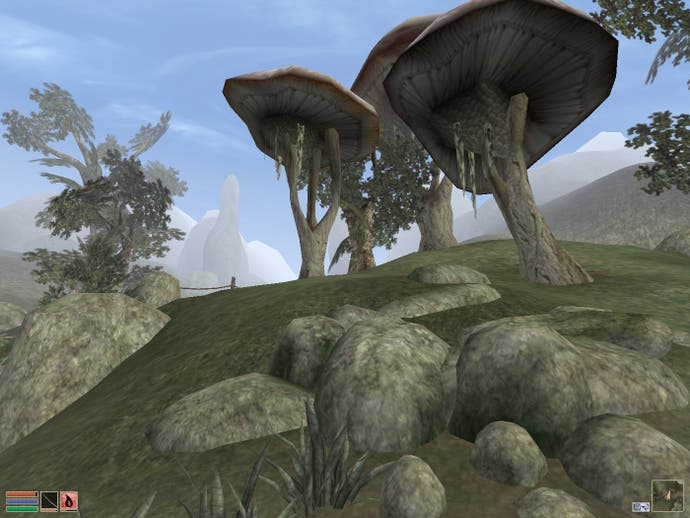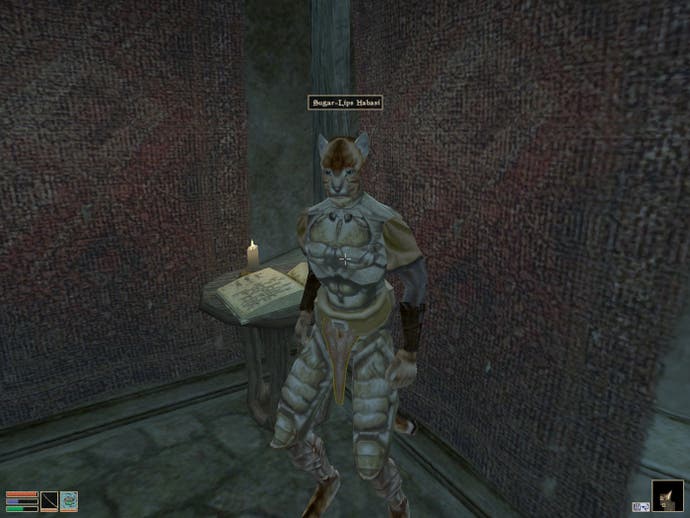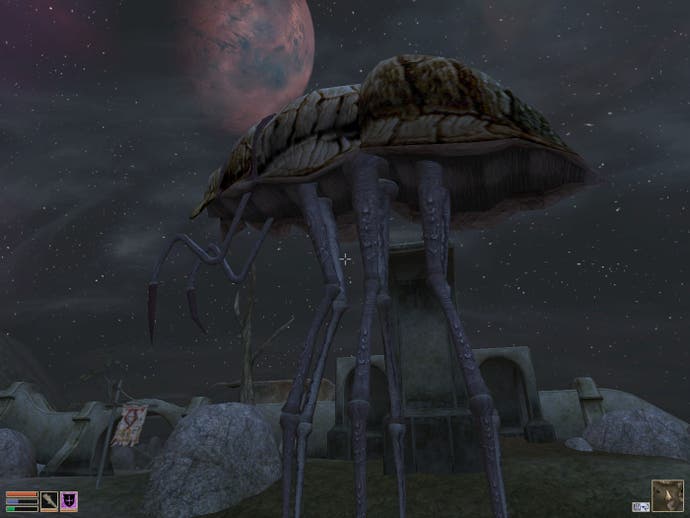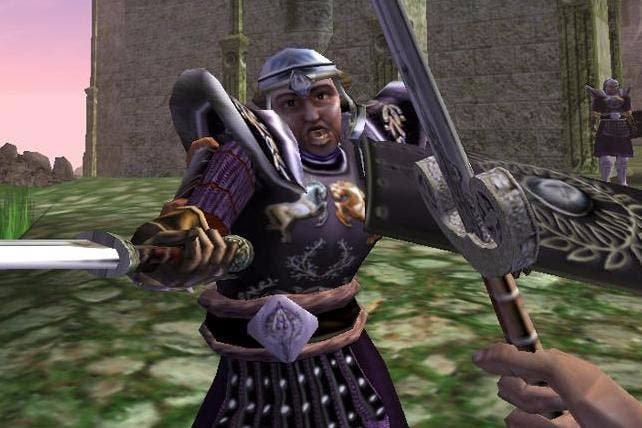Broken dragons: In praise of Morrowind, a game about game design
Vivec la difference.
The appeal of Morrowind for a first-time player today is surely that of getting lost. The game's once-breathtaking Gamebryo engine may creak with age, and its brittle, RNG-heavy combat may seem relentlessly archaic, but Morrowind's relative shortage of navigational aids now feels positively radical.
Most currently prospering open world RPGs are littered with waypoints and breadcrumb trails, their treasures and secrets tagged for consumption once you've accosted the relevant NPC. Approach somebody about a quest in Morrowind, by contrast, and you'll be handed a list of directions. There are no omni-visible floating diamond icons, no distance-to-arrival readouts - just a series of landmarks and turnings, scribbled down in your increasingly unwieldy journal. Returned to after a decade's worth of Assassin's Creed and Far Cry, it's all rather terrifying, like sobering up in the middle of a busy motorway.

The directions aren't even universally reliable, or exact. Sometimes you have little to go on beyond the name of a region - there's a mission to locate somebody near Red Mountain that plays out like a Hunter Thompson rewrite of Christ roaming the wilderness, in which you fend off screeching winged vermin while combing the dunes for your quarry. Due to be resurrected this summer as an expansion for The Elder Scrolls Online, Morrowind isn't a particularly large or impenetrable world - its roads well-signposted, its towns clustered close together - but having to actually look for the place you're looking for is invigorating, a show of faith in both the player's patience and the environment's intelligibility. And my, what an environment to get lost in - with its balding purple hills that reveal themselves to be enormous toadstools on closer inspection, its Dunmer citadels that evoke the stepped sandstone mounds of Angkor Wat.
You might read all that back and conclude that Morrowind feels more "real", or at least, more "grounded" than many of its peers and successors - a world shorn of those gamey contrivances and conveniences that can't help but expose the simulation for a sham, even as they help you explore. The truth is a little more complex, not to say mercilessly arcane. Morrowind has plenty of implausible UI elements, for starters - an ever-present minimap, the ability to pause inches from death in order to scoff down 20 Kwama eggs in one go - but more importantly, it's one of those games that knows it's a fantasy, commenting on its own artifice throughout.
Games that know they're games can, of course, be incredibly tiresome - see also, the hilarious scriptwriter's gambit of having characters moan about fetch-quest design in the middle of a fetch-quest - and there are shades of this kind of humour in your first meeting with Vivec, Morrowind's gangly Yoda of a god-king. Like many an RPG ruler before, he calls on you to save the realm from an otherworldly menace, but as the scene unfolds his address grows almost mocking, labouring the options with a care that borders on parody. "You may accept the gift, then do with it as you will," Vivec comments. "You will receive the responsibility as an oath. You may give your oath, then keep it or break it as you like." It's almost as though he's taking the piss out of your essential detachment, pointing to the fact that, much as NPCs may waffle about destiny and duty, a player is quite capable of indulging some impulse for hours on end while the universe teeters on the brink of ruin.

The writers' agenda goes beyond poking fun, however. I should probably offer the caveat at this point that where Elder Scrolls lore is concerned I am but an apprentice, weaned on the fields of Skyrim and only recently acquainted with Vvardenfell. I am almost certainly going to get something horribly wrong. I do, however, know somebody who has a firmer grasp of the lore - the interactive fiction designer Kateri, who has blogged at length on the subject of Morrowind's metaphysics and its chronic habit of breaking the fourth wall. Except that "breaking the fourth wall" is probably an unhelpful phrase here, implying as it does a clean separation between how we experience the world within a game and how we process the world outside it. Whereas what Morrowind's meta-textual asides implicitly propose is that its various contrivances echo how we interpret existence in general.
Where were you when the Dragon broke? Much debated on Elder Scrolls forums and subreddits, "dragon breaks" refer to points in the Elder Scrolls chronology when Time itself - known to friends as Akatosh - is shattered by some divine or diabolical agency, plunging the fabric of history into chaos. One such rupture recalled in Morrowind's prodigious libraries took place roundabouts the conclusion of The Elder Scrolls 2: Daggerfall. Accounts of the period vary wildly, from scholar to scholar and species to species. According to one set of human historians, the empire of Cyrodiil became an egg, drifting across the stars. According to a Dark Elf writer, the borders of each kingdom "shifted like snakes" and the concept of before and after imploded. One thing most sources seem to agree on is that 1008 years passed in the space of 150, with several contradictory chains of events unfolding simultaneously, before the phenomenon somehow ebbed away and Time reverted to a single, coherent form.
As Kateri points out, the "dragon break" is to some degree just a highly ornate deus ex machina, a video game chronicler's sleight-of-hand. Daggerfall, after all, is a game with multiple endings. The usual approach when crafting follow-ups to such games is to pick a "canonical ending", but Bethesda's writers, amongst them the architect of many of Tamriel's philosophical forays, Michael Kirkbride, were unwilling to let all those probabilities fade away. Hence the idea of a temporal breach resulting from the player character's actions in Daggerfall, allowing all seven endings to retain a certain validity while still giving Morrowind a tidy foundation to build on.

But there's more to Daggerfall's dragon break than ducking the need for a definitive outcome, or merely cracking wise about the hiccups of an interactive narrative. Woven into Morrowind's recounting of the dragon break is a lesson about the fragility of history - an understanding that accounts of the past are multiple and contradictory and that time itself is a flexible quantity, susceptible to the vagaries of perception and memory. Humans are good at "gaming" what we experience, at creating connections because it suits our needs or whims, even as we profess to be concerned with objective truths - this is the basis of superstition. Morrowind's origin stories are commentaries on this - they further the notion that what we call "reality" is the product of selective filtering, even as the game's relative lack of HUD guidance now makes for a more "realistic-feeling" world.
This entwining of lore conceits with design considerations carries over to other Elder Scrolls games, but Morrowind is, I think, unique thanks to Vivec - an NPC who "knows" that he is a figment of somebody's imagination, and has used this knowledge in various ways to gain power over a realm. I'll leave Kateri to dig into the fine detail there, but suffice to say Vivec's books of (often barely legible) sermons are littered with references to the tics and quirks of game design - the concept of a modding toolset is alluded to in a text on the "provisional house", for example. Michael Kirkbride's habit of posting under Vivec's name to explain some facet of the lore is, of course, a bit of a clue as to his role within the fiction.

It's this, for me, that makes Morrowind worth revisiting, much as the game's clumsy and unintuitive combat may frustrate. It's part of that rare pantheon of games that apply themselves imaginatively to what other designers might term the constraints of design, technology or production - a game that sees the apparatus of, say, saving your game not as an artificial structure that must be ignored, explained away or guiltily made fun of, but as a means of continuing the fantasy.
I was reminded of Morrowind while playing Sophia Park's recent browser story Forgotten, which you should absolutely try before reading anything else about it. Crafted over a week with the aid of artist Arielle Grimes, it poses an old-school DOS game world in which gods and monsters have achieved some measure of sentience in the player's absence, erecting a new reality after deleting their game's "help" file, only to fetch up against their computer's memory limitations. In asking questions of these sad, confused abominations, dumping queries into what precious bytes of memory remain, you are literally using up their capacity to think. It's a brief, beautiful tragedy that, again, treats the apparatus of design and hardware as an extension of the drama.
There are other reasons to return to Morrowind. The island of Vvardenfell is a more unusual setting than either Oblivion's stately Cyrodiil or the Conan-esque wilds of Skyrim, and the game's spell-making, enchanting and crafting systems are knottier than those of its relatively mass-market-friendly successors. But it's that sense of whimsical yet studied unreality, that ability to actively capitalise on the fact that this is all illusion, which perhaps elevates Morrowind above any other Elder Scrolls title, before or since.









